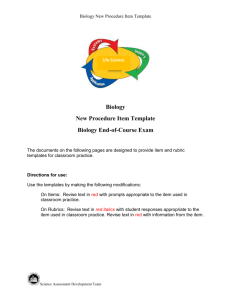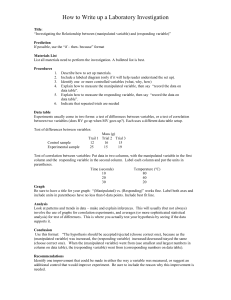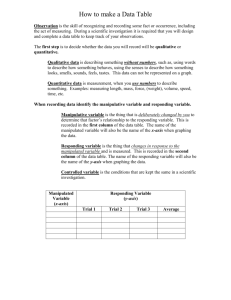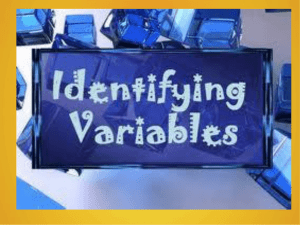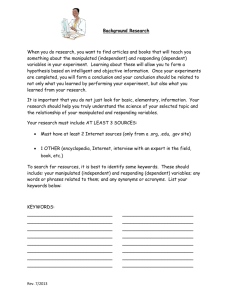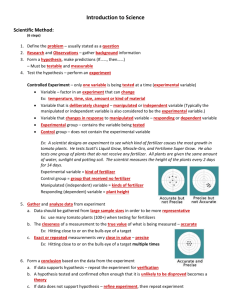Biology Conclusion Item Template
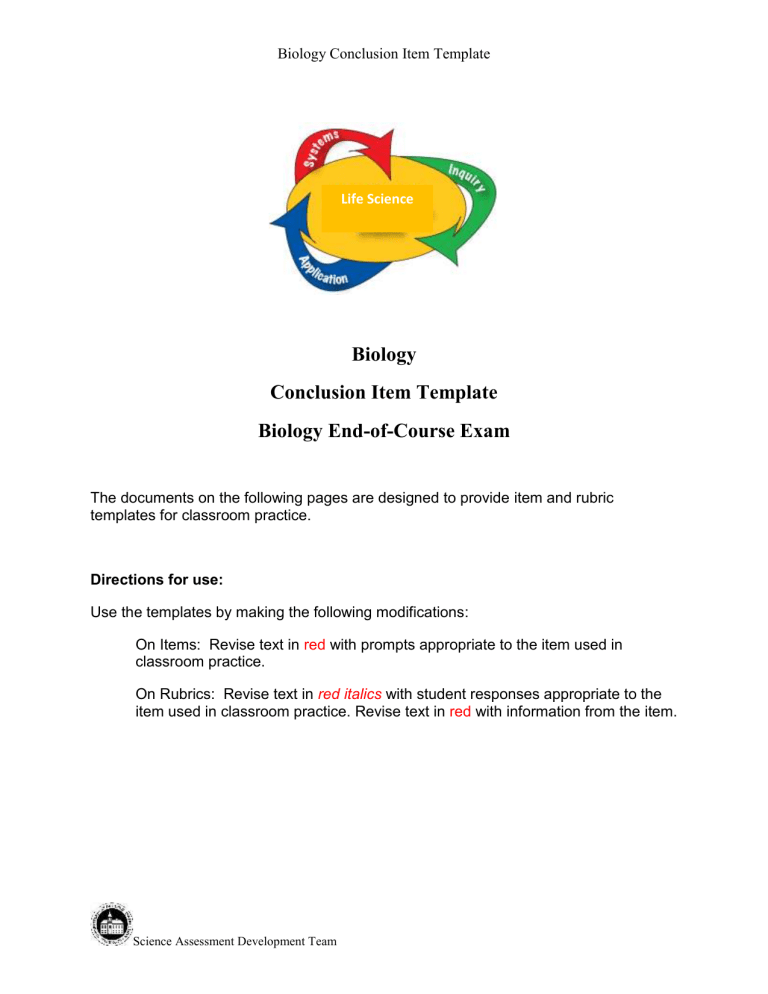
Biology Conclusion Item Template
Life Science
Biology
Conclusion Item Template
Biology End-of-Course Exam
The documents on the following pages are designed to provide item and rubric templates for classroom practice.
Directions for use:
Use the templates by making the following modifications:
On Items: Revise text in red with prompts appropriate to the item used in classroom practice.
On Rubrics: Revise text in red italics with student responses appropriate to the item used in classroom practice. Revise text in red with information from the item.
Science Assessment Development Team
Biology Conclusion Item Template
0
Write a conclusion for this controlled experiment/field study .
In your conclusion, be sure to:
Answer the experimental/field study question.
Include supporting data from the Manipulated (Independent) Variable vs.
Responding (Dependent) Variable table.
Explain how these data support your conclusion.
Provide a scientific explanation for the trend in the data.
(See Writing Note on page 3 of rubric.)
Question: What is the effect of the manipulated (independent) variable on the responding (dependent) variable ?
Conclusion:
Biology Conclusion Item Template
Scoring Rubric for: Write a Conclusion (page 1 of 3)
Performance Description
A 2-point response demonstrates the student understands the Content Standard INQC:
Conclusions must be logical, based on evidence, and consistent with prior established knowledge.
Item Specification 1: Generate a logical conclusion that is supported by evidence from the investigation and/or provide a scientific reason to explain the trend in data given a description of and the results from a scientific investigation.
Example: Include a normal 2-pt. student response (e.g., As the manipulated variable increased, the responding variable increased. When the manipulated variable was X lowest
, the responding variable was the lowest, Y lowest
. When the manipulated variable was X highest
, the responding variable was Y highest
. So changing the manipulated variable by X caused the responding variable to increase/decrease by Y. The responding variable changed because of this scientific reason.)
Attributes
4-5
A 1-point response demonstrates the student has partial understanding of the Content Standard. 2 -3
A 0-point response demonstrates the student has little or no understanding of the Content
Standard.
Manipulated Variable vs. Responding Variable
Manipulated
Variable
(units)
Responding Variable
(units)
Trial 1 Trial 2 Trial 3 Trial 4 Average
0–1
Lowest condition
Condition 2
Condition 3
Highest condition
Biology Conclusion Item Template
Scoring Rubric for: Write a Conclusion (page 2 of 3)
Attributes of a Conclusion
Note: The italicized print is the part of the “Example” credited for the attribute.
Description
Conclusive statement correctly answers the experimental question (or correctly states whether the hypothesis/prediction was correct): As the manipulated variable increased, the responding variable increased.
Attributes
Attribute Notes:
1.
A vague conclusive statement (e.g., the manipulated variable change did affect the responding variable ) cannot be credited for this attribute, but other attributes can be credited.
2.
A response with an incorrect conclusive statement or no conclusive statement may not be credited any attributes.
3.
A response with both a correct and an incorrect conclusive statement (e.g., as X increased Y decreased … as X got smaller so did Y ) cannot be credited for this attribute but other attributes can be credited, if separate from any contradictory statements.
1
Supporting data should at least be over the entire range of the conditions investigated. Thus the minimum reported data are the lowest and highest conditions of the manipulated variable for quantitative data (responding variable when the manipulated variable information is descriptive).
Supporting data for lowest condition : When the manipulated variable was X lowest
, the responding variable was the lowest, Y lowest.
Supporting data for highest condition : When the manipulated variable was X highest
, the responding variable was Y highest
.
Explanatory language , separate from the conclusive statement, is used to connect or compare the supporting data to the conclusive statement: So changing the manipulated variable by X caused the responding variable to increase/decrease by Y.
Attribute Notes:
1.
This attribute can only be credited when at least one numeric value (or the text from a descriptive data table) for the manipulated or responding variable is included in the response.
2.
A copy of the conclusive statement cannot be credited for explanatory language. However, a re-phrased credited conclusive statement can be credited.
3.
Explanatory language comparing the range of the manipulated and/or responding variables may be credited (e.g., The lowest condition of the manipulated variable tested was XXX and the responding variable was only YYY .)
4.
If a response misquotes trend data between the highest and lowest conditions, this attribute cannot be credited.
5.
Transitional words (e.g., however, therefore, because, so, then, clearly, but ) cannot be credited as explanatory language even when added to a conclusive statement.
6.
A compound sentence as a conclusive statement may be read as two separate sentences.
1
1
1
Biology Conclusion Item Template
Scoring Rubric for: Write a Conclusion (page 3 of 3)
Attributes of a Conclusion
Note: The italicized print is the part of the “Example” credited for the attribute.
Description
Scientific Explanation provides a plausible scientific reason that explains the trend seen in the data table in terms of established scientific knowledge.
Examples:
The responding variable changed because of this scientific reason.
Writing Note: This attribute is only included when the scientific reason for the trend shown in the data is expected knowledge for biology students based on the K-12 Science Learning Standards.
Attributes
1
Total Possible Attributes 5
General Notes:
1.
Copying the Data Table: Responses copying the whole data table verbatim may not be credited the supporting data attribute even with a correct conclusive statement and explanatory language. a) For grades 4-5, a translation of the whole data table into sentences is acceptable. b) For grades 6-8 and high school, a discussion of the whole data table may be acceptable when the data table is minimal with a very small number of data cells.
2.
Supporting Data: Responses must give the precise numerical values or precise descriptive language from the data table for both the manipulated and responding variables. a) Average data (if given) or data from the end of the investigation, must be included for grades 6-8 and high school. b) For grades 4-5, consistent trial data, or data before the completion of the investigation when measuring a responding variable over time, can be credited. c) Rounded numerical values cannot be credited (e.g., give examples cannot be credited). However, a zero after a decimal point may be omitted (e.g., give examples can be credited). d) Units are not necessary for credit (e.g., give examples ). e) Minor language differences in descriptive data may be acceptable as decided in rangefinding
(e.g., give examples if applicable ). f) For grades 4-5, the manipulated variable may be implied.
3.
Derived Data: Responses giving their own derived data between conditions can be credited for supporting data and explanatory language (e.g., Changing the manipulated variable by X caused the responding variable to increase/decrease by Y ). a) When the derived data uses the lowest and/or highest conditions, one or both supporting data attributes can be credited. b) Minor arithmetic errors in derived values can be acceptable as decided in rangefinding
(e.g., give item specific examples when appropriate ).

